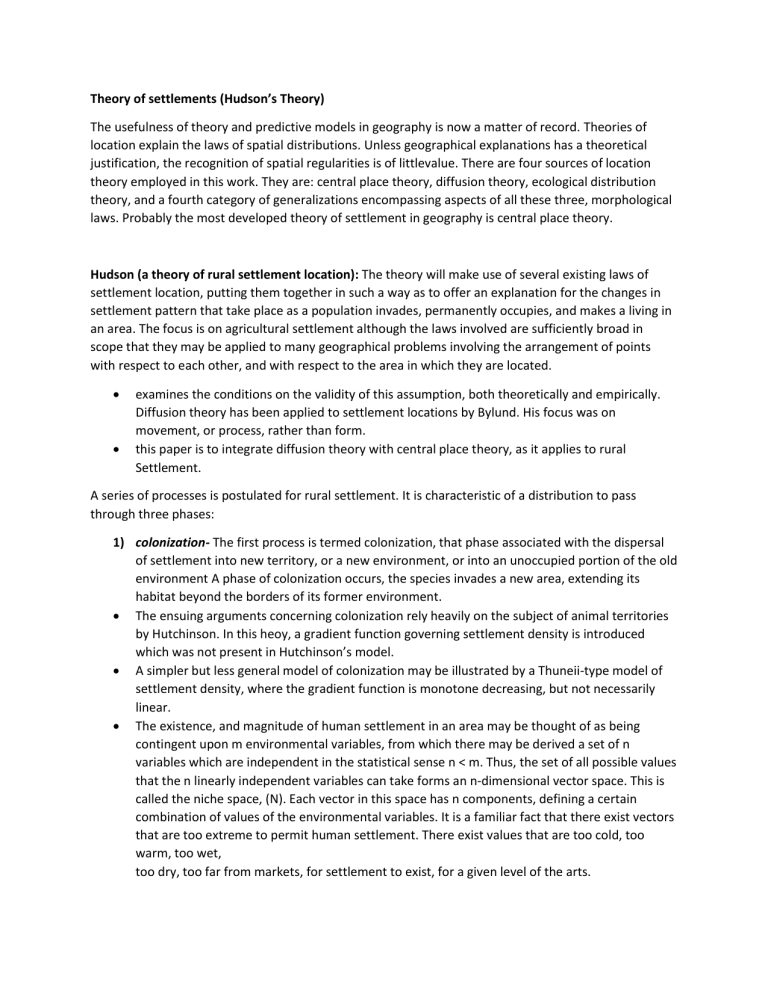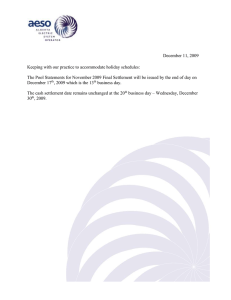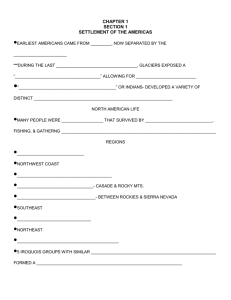
Theory of settlements (Hudson’s Theory) The usefulness of theory and predictive models in geography is now a matter of record. Theories of location explain the laws of spatial distributions. Unless geographical explanations has a theoretical justification, the recognition of spatial regularities is of littlevalue. There are four sources of location theory employed in this work. They are: central place theory, diffusion theory, ecological distribution theory, and a fourth category of generalizations encompassing aspects of all these three, morphological laws. Probably the most developed theory of settlement in geography is central place theory. Hudson (a theory of rural settlement location): The theory will make use of several existing laws of settlement location, putting them together in such a way as to offer an explanation for the changes in settlement pattern that take place as a population invades, permanently occupies, and makes a living in an area. The focus is on agricultural settlement although the laws involved are sufficiently broad in scope that they may be applied to many geographical problems involving the arrangement of points with respect to each other, and with respect to the area in which they are located. examines the conditions on the validity of this assumption, both theoretically and empirically. Diffusion theory has been applied to settlement locations by Bylund. His focus was on movement, or process, rather than form. this paper is to integrate diffusion theory with central place theory, as it applies to rural Settlement. A series of processes is postulated for rural settlement. It is characteristic of a distribution to pass through three phases: 1) colonization- The first process is termed colonization, that phase associated with the dispersal of settlement into new territory, or a new environment, or into an unoccupied portion of the old environment A phase of colonization occurs, the species invades a new area, extending its habitat beyond the borders of its former environment. The ensuing arguments concerning colonization rely heavily on the subject of animal territories by Hutchinson. In this heoy, a gradient function governing settlement density is introduced which was not present in Hutchinson’s model. A simpler but less general model of colonization may be illustrated by a Thuneii-type model of settlement density, where the gradient function is monotone decreasing, but not necessarily linear. The existence, and magnitude of human settlement in an area may be thought of as being contingent upon m environmental variables, from which there may be derived a set of n variables which are independent in the statistical sense n < m. Thus, the set of all possible values that the n linearly independent variables can take forms an n-dimensional vector space. This is called the niche space, (N). Each vector in this space has n components, defining a certain combination of values of the environmental variables. It is a familiar fact that there exist vectors that are too extreme to permit human settlement. There exist values that are too cold, too warm, too wet, too dry, too far from markets, for settlement to exist, for a given level of the arts. 2) spread- biological renewal produces a regeneration of the species through an increase in numbers with a general tendency to short distance dispersal, filling up the gaps in the distribution formed by the original colonizers, and as time passes the process is checked by a third set of forces. The second process is termed spread. Characteristic of spread is increasing population density, creation of settlement clusters and eventual pressure on the environment, both physical and social 3) competition- The third process, competition, is best documented in geographical location theory. It is this process that tends to produce great regularity in the settlement pattern and in turn produces one condition for the regular network of central places. owing to limitations of the environment, weak individuals are forced out by their stronger neighbors, density tends to decrease, and pattern stabilizes. The process of competition is a struggle between settlements to hold their domains intact and to increase their holdings. Larger settlements absorb smaller ones, just as large trees get greater nourishment by blocking sunlight from smaller trees near them.23 Trade centers do the same thing. There exists a finite amount of purchasing potential spread over the hinterlands. Towns must compete with one another for customers, extending their trading areas as far as possible. Those centers with a disadvantageous position on the map are squeezed out. biotope increases as a result of colonization or spread, there occurs an upper limit to the area of the biotope, which checks growth. Ecologists refer to these types ofchecks on population as density-dependent conditions. In animal populations, density dependent conditions are those of exhaustion of the available food supply. The counterpart in rural settlement is that there is a lower limit on the size of farm that can be operated economically. Increase in prices may bring smaller farms into production (change in volume of the niche space), but even with such a condition, the biotope is of finite size and so are the farms, and the process is inevitably checked.


